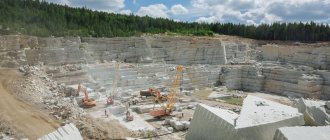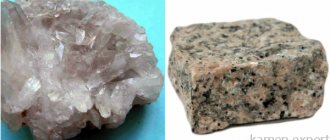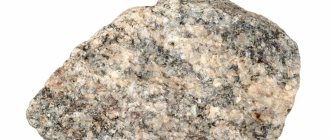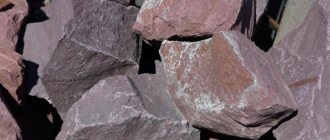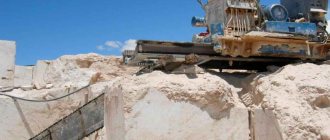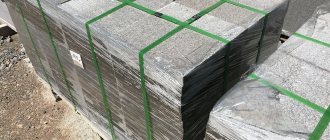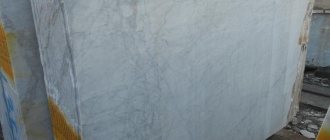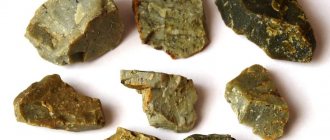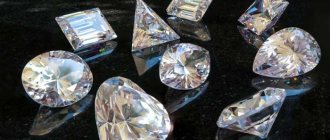The density of a stone is the ratio of the mass of a stone to the mass of water of the same volume. Stone density has a value from 1 to 20. Stones with a value less than 2 are light. Stones with a value from 2 to 4 are of normal weight, and stones with a value of more than 4 are heavy. High-density stones such as diamonds, rubies, sapphires are much heavier than rock-forming stones such as quar and feldspar, and due to this, in fast rivers, high-density stones are deposited earlier and form placer deposits. Mineral density is used to identify stones. The average density of a stone is determined by two methods: the method of hydrostatic weighing of the stone and the method of immersing the stone in heavy liquids.
A natural stone. Marble. Granite. Quartz stone.
We provide useful information for calculating the weight of stone products: marble, granite, travertine and the weight of quartz stone.
During the work process or when calculating delivery, there is a need for data on the weight of products made of marble, granite and quartz stone.
►Prices for cutting marble
►Prices for profile processing (marble end)
Method of immersion in heavy liquids
This method is very complicated and much more expensive than the first, but it does not take much time. This method is used to identify real stones from artificial stones and fakes. This method is based on the property of heavy water in which solid objects do not sink to the bottom and do not float, but are as if suspended, provided that their density is the same. The stone is first placed in very heavy water, and the stone will be squeezed out to the surface by the water. Then the heavy water begins to be diluted with distilled water, while the density of the water will gradually decrease and when the density of the water becomes equal to the density of the stone, the stone will go into a suspended state. After this, you need to measure the density of the water and you can identify the stone using the table. The density of dilute heavy water is determined in laboratory conditions using special Westphal balances. Stone density table.
| Stone | Density | Stone | Density | Stone | Density |
| Tantalite | 5,18—8,20 | Diamond | 3,47—3,55 | Aquamarine | 2,67—2,71 |
| Cassiterite | 6,8—7,1 | Titanite | 3,52—3,54 | Eye of the Tiger | 2,64—2,71 |
| Wulfenite | 6,7—7,0 | Gemimorphite | 3,52—3,54 | Augelite | 2,7 |
| Galliant | 7,05 | G hypersten | 3,4—3,5 | Marble onyx | 2,7 |
| Cerussite | 6,46—6,57 | Singalit | 3,47—3,49 | Labradorite | 2,69—2,7 |
| Cuprite | 5,85—6,15 | Vesuvian | 3,32—3,42 | Corals | 2,6—2,7 |
| Phosgenite | 6,13 | Dumortierite | 3,26—3,41 | Vivianite | 2,6—2,7 |
| Crocoite | 5,9—6,1 | Epidote | 3,4 | Cordierite | 2,58—2,66 |
| Sheelit | 5,1—6,1 | Rodicite | 3,4 | Aventurine | 2,65 |
| Dzhevalit | 5,60—5,71 | Purpurite | 3,2—3,4 | Rock crystal | 2,65 |
| Zincite | 5,66 | Peridot (peridot) | 3.27—3.37 | Citrine | 2,65 |
| Proust | 5,57—5,64 | Jade | 3,30—3,36 | Prasiolite | 2,65 |
| Pyrite | 5,0—5,2 | Tanzanite | 3,35 | Smoky quartz (rauchtopaz) | 2,65 |
| Hematite | 4,95—5,16 | Dioptase | 3,28—3,35 | Rose quartz | 2,65 |
| Fabulite | 5,13 | Cornerupin | 3,28—3,35 | Amethyst | 2.63—2,65 |
| Chromite | 4,1—4,9 | Diopside | 3,27—3,31 | Aventurine feldspar | 2,62—2,65 |
| Ilmenite | 4,72 | Axinite | 3,27—3,29 | Agate | 2,60—2,65 |
| Zircon | 3,90—4,71 | Ekanite | 3,28 | Moss agate | 2,58—2,62 |
| YAG grenade | 4,6 | Enstatite | 3,26—3,28 | Eleolith | 2,55—2,65 |
| Barite | 4,5 | Tourmaline | 3,02—3,26 | Chalcedony | 2,58—2,64 |
| Smithsonite | 4,3—4,5 | Sillimanite | 3,25 | Chrysoprase | 2,58—2,64 |
| Psilomelan | 4,35 | Smaragdite | 3,25 | Peristerite | 2,61—2,63 |
| Witherite | 4,27—4,35 | Apatite | 3,17—3,23 | Moon rock | 2,56—2,62 |
| Rutile | 4,20—4,30 | Giddenite | 3,16—3,20 | Orthoclase | 2,56—2,60 |
| Chalcopyrite | 4,1—4,3 | Kunzite | 3,16—3,20 | Pseudofit | 2,5—2,6 |
| Spessartine | 4,12—4,20 | Lazulite | 3,1—3,2 | Variscite | 2,4—2,6 |
| Almandine | 3,95—4,20 | Fluorite | 3,18 | Obsidian | 2,3—2,6 |
| Rhinestone | 3,15—4,20 | Andalusite | 3,12—3,18 | G ovlite | 2,53—2,59 |
| Willemite | 3,89—4.18 | Magnesite | 3.00—3.12 | Sanidin | 2,57—2,58 |
| Painite | 4,1 | Euclase | 3,10 | Amazonite | 2,56—2,58 |
| Sphalerite | 4,08—4,10 | Tremolite | 2,9—3,1 | Thugtupit | 2,36—2,57 |
| Ruby | 3,97—4,05 | Actinolite | 3,03—3,07 | Leucite | 2,45—2,50 |
| Sapphire | 3,99—4,00 | Amblygonitis | 3,01—3,03 | Cancrinitis | 2.4—2,5 |
| Celestine | 3,97—4,05 | Nephritis | 2,90—3,02 | Apophyllite | 2,30—2,50 |
| Ganit | 3,99—4,00 | Danburite | 3,0 | Colemanite | 2,42 |
| Anataz | 3,58—3,98 | Datolite | 2,90—3,00 | Gayuin | 2,4 |
| Malachite | 3,82—3,95 | Brazilianite | 2,98—2,99 | Petalite | 2,40 |
| Azurite | 3,75—3,95 | Anhydrite | 2,90—2,99 | Thomsonite | 2.3—2,4 |
| Periclase | 3,7—3,9 | Phenakite | 2,95—2,97 | Chrysocolla | 2,00—2,40 |
| Pleonastus | 3,7—3,9 | Dolomite | 2,85—2,95 | Moldavite | 2,32—2,38 |
| Siderite | 3,85 | Aragonite | 2,94 | Hambergite | 2,35 |
| Demantoid | 3,82—3,85 | Prehnite | 2,87—2,93 | Alabaster (gypsum) | 2,30—2,33 |
| Staurolite | 3,7—3,8 | Jasper | 2,58—2,91 | Sodalite | 2,13—2,29 |
| Pyrope | 3,65—3,80 | Lapis lazuli | 2,4—2,9 | Natrolite | 2,20—2,25 |
| Uvarovite | 3,77 | Beryllonite | 2,80—2,85 | Stichtitis | about 2.2 |
| Alexandrite | 3,70—3,73 | Ward it | 2,81 | Opal | 1,98—2,20 |
| Chrysoberyl | 3,70—3,72 | Soapstone (wen) | 2,7—2,8 | Sulfur | 2,05—2,08 |
| Rhodonite | 3,40—3,70 | Turquoise | 2.60—2,80 | Meerschaum (sepiolite) | 2,0 |
| Rhodochrosite | 3,30—3,70 | Serpentine | 2,4—2,8 | Ulexit | 1,9—2,0 |
| Kyanite | 3,65—3,69 | Garnierite | 2,3—2,8 | Ivory | 1,7—2,0 |
| Benitoite | 3,65—3,68 | Emerald | 2,67—2,78 | Geylussite | 1,99 |
| Rossular | 3,60—3,68 | Pearl | 2,60—2,78 | Kurnakovit | 1,86 |
| Baritocalcite | 3,66 | Beryl | 2,65—2,78 | Jet | 1,30—1,35 |
| Spinel | 3,58—3,61 | Bytovnit | 2,71—2,74 | Amber | 1,05—1,30 |
| Taafeit | 3,6 | Scapolite | 2,57—2,74 | ||
| Topaz | 3,53—3,56 | Calcite | 2,71 |
For this method, only heavy water is suitable and can be diluted with distilled water. Very often solutions of Thule, Clerici and Sushin are used as heavy water.
- Thule solution has a density of 3.2 and can identify a very large number of stones. This solution consists of double potassium iodide and mercury.
- Clerici's solution is toxic and has a density of 4.2, so it is used to identify heavier stones. This solution contains thallium formate and malonate, so this solution is very expensive.
- Sushin's solution has a density of 3.5. This solution consists of a solution of barium iodide and mercury.
All heavy solutions after dilution can be restored to their original density by conventional evaporation in a water bath. If the stone is clean and not diluted with other minerals, then you will determine the very accurate density of this stone using this method.
Specific gravity of granite: table of average values in 1 sq.m.
| Plate thickness, mm | Granite weight per 1 sq.m. |
| granite thickness 20 mm | 56 kg. / sq.m. |
| granite thickness 30 mm | 87 kg. / sq.m. |
| granite thickness 40 mm | 116 kg. / sq.m. |
| granite thickness 50 mm | 138 kg. / sq.m. |
| granite thickness 60 mm | 200 kg. / sq.m. |
| granite thickness 70 mm | 193 kg. / sq.m. |
| granite thickness 80 mm | 220 kg. / sq.m. |
| granite thickness 90 mm | 248 kg. / sq.m. |
| granite thickness 100 mm | 275 kg. / sq.m. |
Strength of natural stone
Natural stones differ not only in their decorative properties, but also in strength, density, porosity, water absorption and abrasion rate. The wear resistance of the material depends on the strength. Natural stones of high strength begin to deteriorate no earlier than after 500 years (granite, quartzite, slate), and of medium strength they can be destroyed after 50-75 years (dolomite, limestone, travertine). Materials such as shell rock can be destroyed in 30 to 50 years. But due to special water-repellent agents, which can significantly increase the resistance of the material to negative external influences, the main problem of the low mechanical strength of such natural materials is solved. After special treatment, the stone can be used even in places with harsh weather conditions.
Extraction of rubble stone in a quarry
Natural rubble stone is mainly mined in open pits. The drilling and blasting method and the sawing method are used.
- The drilling and blasting method is used for the extraction of limestone, sandstone, and granite. Using the explosion method, large stones with uneven edges are obtained, then they are distributed into fractions. Open pit mining is divided into three stages - blasting, loading and removal from the quarry.
- Sawing is used to obtain building materials from soft rocks. Sawing and blasting are carried out in different quarries, since explosions affect the appearance of cracks in stones.
The extracted stone is delivered to the construction site by heavy vehicles, in wagons by rail, and much less often by water transport.
Abrasion index
The abrasion index refers to natural stone, which is used for paths, stairs, floors and platforms.
Rocks and materials according to the degree of abrasion (at a human traffic intensity of 1 million people per year (mm)) can be conditionally divided into the following. groups: 1. Quartzites and rocks of the granite group - less than 0.12 2. Loose basalts, marble, sandstones, dolomites, dolomitized limestones - 0.35 - 0.5
3. Marbled limestones, travertines, limestones, tuffs - 0.6 - 1.5
4. Loose limestones - 1.5 - 2.5
Based on the above properties, the following tables can be compiled.
Comparative table of natural stone properties
| Properties | Dolomite | Limestone | Slate | Quartzite | Travertine | Shell rock |
| Decorativeness | The surface of the stone is smooth, the color is usually monochromatic (red, green, gray, white, pink) | The stone is even, smooth, with a unique relief pattern. The color range is varied: yellow, green, black, orange-brown | The stone is smooth, interspersed with mica, shimmers brightly in the sun. Color range: gray-green with silver splashes, red with golden mica splashes | The stone is smooth and even, with unique patterns and soft colors: pink, yellow, beige, dark beige. Ideal for processing and interior | The stone is smooth and even, interspersed with shells, giving an amazing pattern to the stone. Colors: pink, beige. Ideal for processing and interior | |
| Strength | Average | High | Average | |||
| Density (kg/m3) | 1100-2300 | 2200-2400 | 2600-2700 | 1100-2300 | ||
| Porosity (%) | 5% > P > 20% | 5% > P >20% | P < 5% | 20% < P < 40% | ||
| Water absorption | 2,7% | 0,01-3% | 0,59% | 2,7-4,93% | ||
| Abrasion (mm), 1 million people/year | 0,35-0,6 | 0,6-1,5 | 0,12-0,35 | less than 0.12 | 0,6-1,5 | 1,5-2,5 |
How to calculate the mass of granite?
m = a*b*h*ρ.
- m – mass of granite
, kg/m2; - a – slab width, m;
- b – length, m;
- h – slab height, m;
- ρ – rock density, kg/m3.
Interesting materials:
Why doesn't iPhone see Apple TV? Why did the channels disappear? Why do the brushes on the angle grinder spark? Why an artificial Christmas tree? Why did mercury thermometers disappear from sale? Why is a curved monitor bad? Why is there a cactus in the desert? Why is the skating rink called that? Why is there a cold coil in the bathroom? Why are blackberries sour?
Calculating the density of natural stones
How to calculate the average density of a sample stone? The equipment required for this is a scale with a set of weights and the ability to measure the volume of an irregularly shaped sample.
The easiest way to do this is to have a graduated cylinder with a volume of about half a liter. 200-300 ml of water is poured into such a cylinder and a piece of the stone material being studied is placed.
The total volume of samples placed in water is determined by the amount of water displaced by them. Then, by dividing their mass by the calculated volume, the average density of the material is obtained.
Slate - physical and technical characteristics
Volumetric mass: 1200-1400 kg/m3
Limit of compressive strength: - in a dry state: 272 MPa (strong) - in a water-saturated state: 177 MPa (strong) after 50 freezing cycles: 153 MPa (strong) Strength reduction coefficient when saturated with water: 0.65 MPa Water absorption: 0. 1 - 0.3% Abrasion: 0.73 g/cm2 Thermal conductivity: 2.3 W/mk Frost resistance grade: 100 (frost-resistant) Radiation parameter (A eff ERN): 261.7 Bq/kg (class 1)
Go to catalog: Slate
How to find the density of a stone?
How is the density of a stone determined? The procedure is quite simple - we weigh the sample first in air, then in water. According to Archimedes' law, the resulting difference corresponds to the mass of water that the sample displaces. Density is calculated by dividing the mass of the sample in air by this difference.
Depending on their density, minerals can be light, medium, heavy or very heavy. For example, the density of granite stone is 2,600 kg/m³. For reference: the density of light does not exceed 2.5 g/cm³, medium - ranges from 2.5 to 4 g/cm³, heavy - from 4 to 8 g/cm³. Minerals with a density above 8 g/cm³ are considered very heavy stones.
Everything - to nature!
Let us now turn to natural stone materials. As is known, there are several types of them. From a practical point of view, any rock is usually classified into one of two groups - strong or low-strength.
Materials of the first group have a high hardness index and, most often, a medium- or coarse-grained structure. In the so-called unweathered state, they have little water absorption. Other (low-strength) rocks, as the name implies, have much lower strength. They also have a much higher degree of water absorption.
Sometimes when recognizing types of stone, it is necessary to determine its hardness. In field conditions, it is most convenient to do this using the so-called. relative Mohs scale and additional available tools. Such improvised means can be a stylus, a coin, a piece of glass, a file, a steel needle or knife, an ordinary or diamond glass cutter. The average density of a stone is also important in determining its type. Having determined this value, you can identify the breed by referring to special tables.
Do it yourself
If there is no measuring cylinder of sufficient volume in the field, the amount of displaced water can be determined as follows. In any cylindrical metal vessel, just below the top, a hole is punched in the wall with an ordinary nail, then a tube is inserted into it, which you can also make yourself by rolling up any film. Fix it in the cylinder wall with plasticine or any similar material.
Thus, a traveling volume meter is obtained. If this unit is used constantly, it makes sense to solder the tube into steel or brass.

